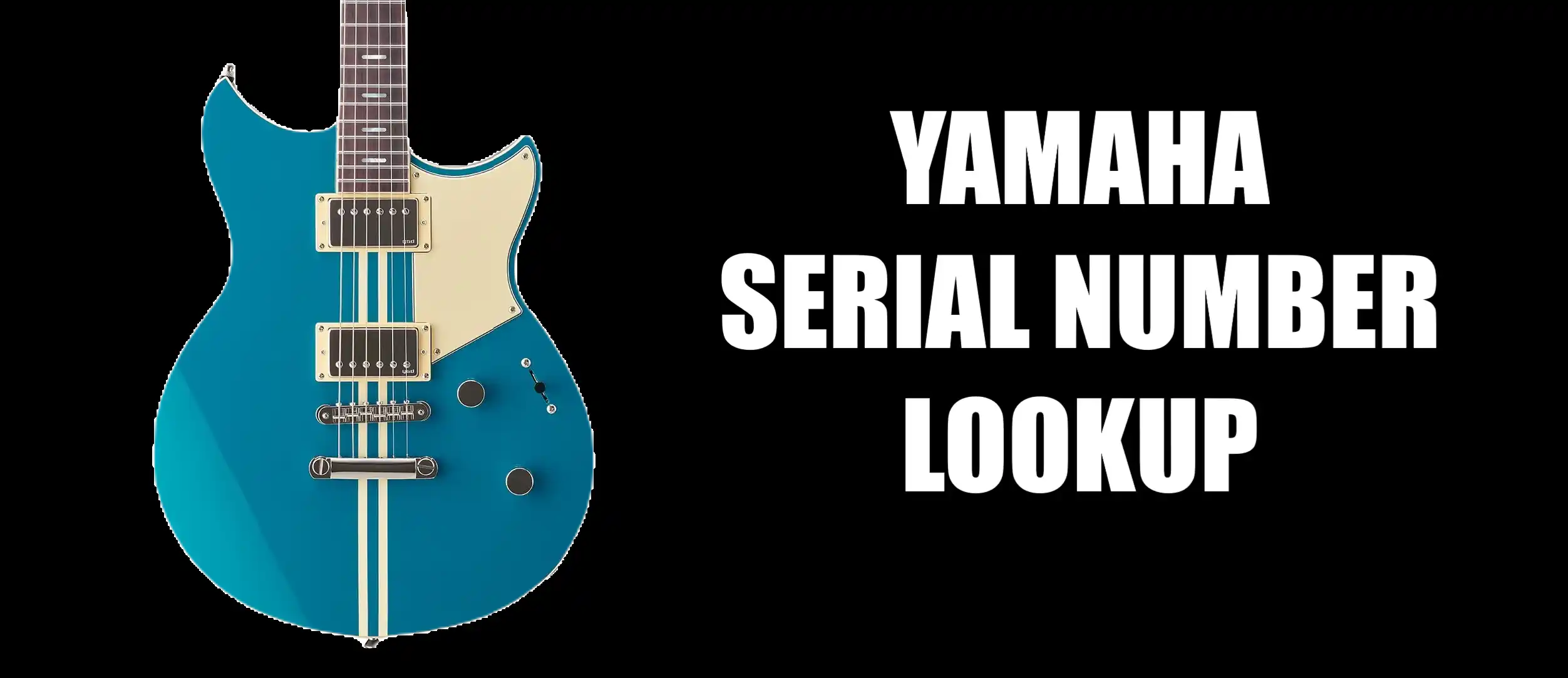
Yamaha employs a convoluted serial number system that can be complex and illogical. Adding to the challenge, a significant portion of the serial numbers repeat every ten years, creating confusion.
Yamaha electric guitar typically has the serial number stamped or punched on the headstock, while Yamaha acoustic guitar usually has the serial number written somewhere inside the sound cavity.
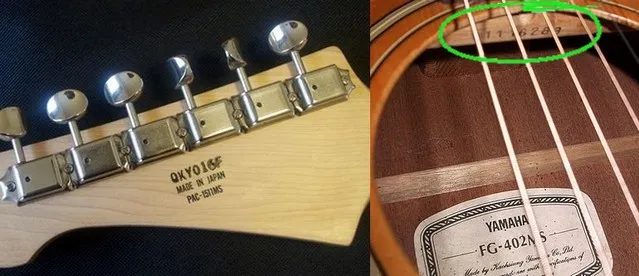
Table of Contents
Yamaha Letter Coding System
Since 2000, the letter system for year and month has been applied at all Yamaha plant locations.
The table below explains the meaning of the letters. As you can see in the table, the letter of the year is repeated every decade.
Yamaha Letter Coding System Year (electric guitars)
| LETTER | YEAR |
|---|---|
| H | 1961, 1971, 1981, 1991, 2001, 2011, 2021 |
| I | 1962, 1972, 1982, 1992, 2002, 2012, 2022 |
| J | 1963, 1973, 1983, 1993, 2003, 2013, 2023 |
| K | 1964, 1974, 1984, 1994, 2004, 2014, 2024 |
| L | 1965, 1975, 1985, 1995, 2005, 2015, 2025 |
| M | 1966, 1976, 1986, 1996, 2006, 2016 |
| N | 1967, 1977, 1987, 1997, 2007, 2017 |
| O | 1968, 1978, 1988, 1998, 2008, 2018 |
| P | 1969, 1979, 1989, 1999, 2009, 2019 |
| Q | 1960, 1970, 1980, 1990, 2000, 2010, 2020 |
Yamaha Letter Coding System Month (Acoustic And electric Guitars)
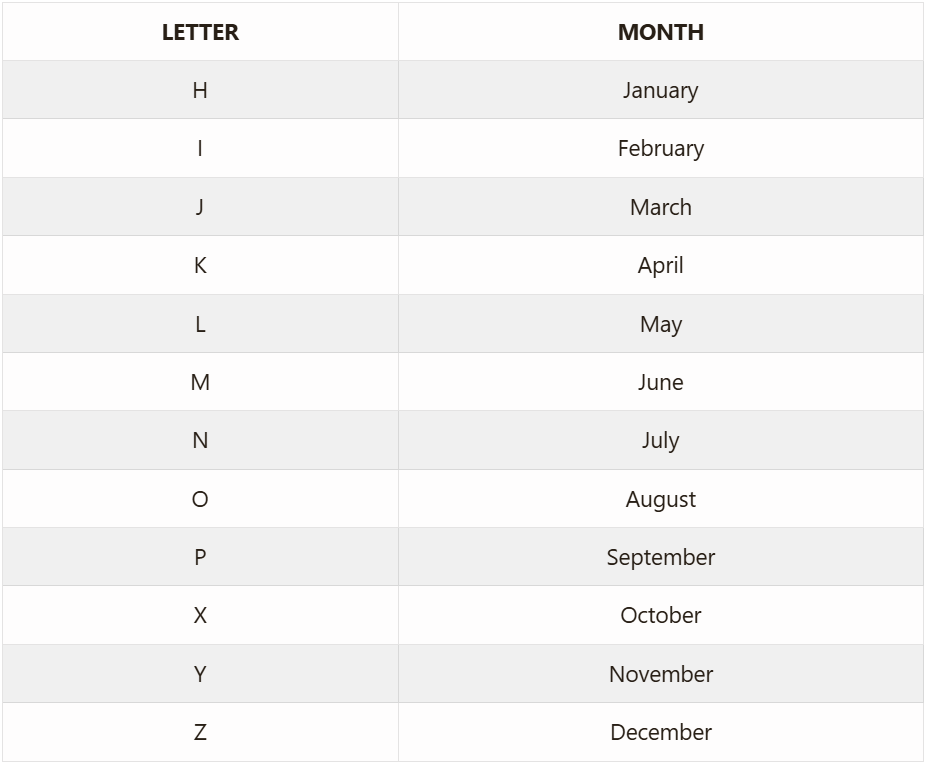
Yamaha Acoustic Serial Number
Japanese Serial Number
TENRYU/WADA FACTORY.
From 1946 to 1968 a 5-digit sequential system is used. However, there is no indication of the year of production in this system.
A nice and simple 6-digit system is used in the period from 1969 to 1984.
The first two numbers represent the year.
The next two digits represent the month.
The last two digits represent the number of the unit (serial number).
Example: 800629
The 29th guitar was built in June 1980.
In the short period of 1985-1986, a 6-digit serial number has been used but the month is not displayed.
The first 2 numbers are the year.
The last 4 digits are the number of the unit (serial number).
Example: 860123
This stands for the 123rd guitar built in 1986.
Yamaha Custom Shop Serial Number
Made in Japan.
In the 1966-1985 period, successive serial numbers from 001 to 1042 were used.
To find the production year, you have to make a rough estimate.
The closer to 001 it is closer to 1966 and the closer to 1042, the closer to 1985.
From 1986 to 1990 the serial numbers have 1 letter followed by 4 digits.
The letter represents the month and follows the same system for months as the most common system. To decode the letter values, see Yamaha letter coding system.
The first number stands for the year.
The last 3 digits represent the number of the unit (serial number).
Example: K8123
This would be a guitar built in April 1988 and the 12th guitar of that day made in the custom shop.
The K is April according to the coding system and the year must be 1988, since this system was only used between 1986 and 1990.
Between 1991 and 1996 one used a 2-letter, 3-digit, then 1-letter system.
The first letter is the year and follows the same coding system.
The second letter is the month and also follows the same coding system.
The 3 numbers represent the unit number, but in this case, the unit numbers started with 701 for unclear reasons. So the first unit of the day was not 001, but 701.
The last letter is an unknown internal factory code.
Example: KN712J
The serial number belongs to the 12th guitar produced in July 1994.
From 1997 to 2003, the same method was applied as for 1991 to 1996 with 2 differences. There is no more internal factory code at the end, and the unit numbers start at 001 instead of at 701.
Example: HL032
The sample serial number here represents the 32nd guitar built in May 2001.
From 2004 to 2022 a 3 letter 3 digit 1 letter system is used.
The first 2 letters represent the year in this case. So you get the decade here.
The third letter represents the month according to the coding system.
The 3 digits represent the number of the unit (serial number).
The last letter is an internal factory code. To decode the letter values, see Yamaha letter coding system.
Example: QNK026C
This guitar in the sample serial number was the 26th guitar built in April 2007.
The Q stands for a 0 and the N is a 7, which means 07 for 2007.
Yamaha Music Craft Serial Number
Made in Japan.
From 1997 through 1999 the same system is used as that for “Custom Shop 1991-1996” except that the unit number starts at 501 except for 701.
From 1999 to 2000 a 2 letter 3 digit system was used.
The first letter is the year.
The second letter is the month.
The 3 digits are the number of the unit (serial number). The unit number starts at 200. To decode the letter values, see Yamaha letter coding system.
Example: PX267
This was the 67th guitar made in October 1999.
From 2001 to 2022 they used a system with 3 letters 3 digits 1 letter.
The first 2 letters represent the year.
The third letter represents the month and the 3 digits are the number of the unit (serial number).
The last letter is an internal factory code.
Example: QJH055B
This would be the 55th guitar that was built in January 2003.
Taiwanese Serial Number
Kaohsiung factory.
An 8-digit system is applied here from 1971-2001.
The first digit represents the year.
The second and third digits represent the month.
The fourth and fifth numbers represent the day of the month.
The last three digits are the number of the unit (serial number).
Since there is only one digit for the year, there are duplicates with this system because it repeats itself every decade.
Example: 60708077
This example serial number was the 77th guitar built on July 8, 1976, 1986, or 1996.
At the end of 2001, the Kaohsiung factory changed the 8-digit system into a 3-letter 6-digit system.
The first 2 letters represent the year.
The third letter represents the month.
The first 2 digits are the day of the month.
The last 4 digits are the number of the unit (serial number).
Example: QNJ220071
The sample serial number is the 71th built guitar on March 22, 2007.
For year: Q (0) + N (7) = 07 (2007). For month J=March (see table below).
Yamaha 3-letter Coding System Year
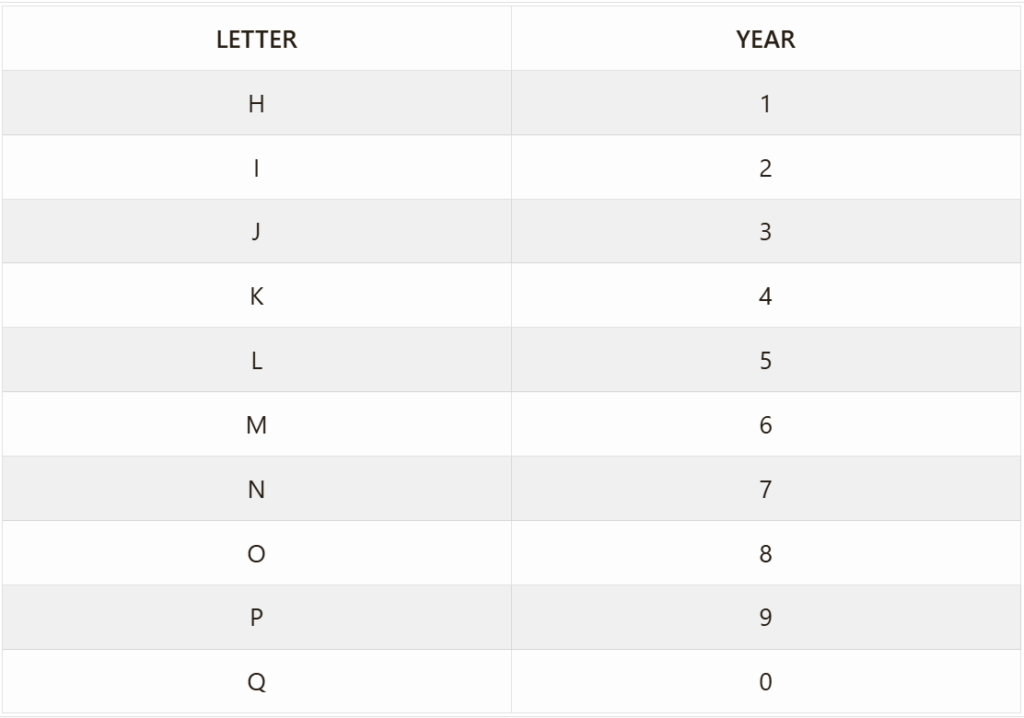
Yamaha 3-letter Coding System Month

Around 1971 Yamaha moved the production of acoustic guitars from Japan to Taiwan. Parts and materials from the factory in Japan were also shipped to the new factory. The first Taiwanese productions had both Japanese-made parts and new Taiwan-made ones.
Sometimes you can find two different serial numbers inside the body. One inside the body under the sound hole and 1 on the neck block.
The number above the neck block is Taiwanese and a valid serial number for the guitar.
The neck block is a part that was already made in Japan, so this is not the correct serial number for the guitar.
Indonesian Serial Number
YMMI (YAMAHA MUSIC MANUFACTURING INDONESIA).
From 1990 to 1996 an 8-digit serial number was used in this factory.
The first digit is the year.
The 2nd and 3rd digits are the month.
The 4th and 5th digits are the day of the month.
The last 3 digits are the number of the unit (serial number).
Example: 40707142
This is the 142th guitar from this factory built on July 7, 1994.
From 1997-1999 the same system is applied here as for 1990-1996, except that there are now 9 digits. The last 4 (instead of 3) is the number of the unit (serial number).
Example: 803290389
This is the 389th guitar from this factory built on March 29, 1998.
In 2000 the system changed from 9 to 10 digits. The first 2 digits represent now the year, the rest is the same coding method.
Example: 0010160701
This is the 701th guitar from this factory built on October 16, 2000.
YMMI changed its coding to a 3-letter 6-number system in 2001.
The first 2 letters represent the year.
The third letter represents the month.
The first 2 digits are the day of the month.
The last 4 digits are the unit number (serial number). To decode the letter values, see Yamaha 3 letter coding system.
Example: HKP220234
This is the 234th guitar built on September 22, 2014.
Yamaha Electric Guitar Serial Number
Yamaha has used several different serial number formats for electric guitars at one time. Below is a breakdown of each format, with a full explanation and examples.
Made in Japan Serial Number Formats
1966–1984: numeric format.
Serial numbers for Yamaha SG, SX, and BB series.1966-1984.
| Models | Serial Number Sequence | Year |
|---|---|---|
| SG-2, 3, 5, 7, 12 | 0398–3951 | 1966 |
| SG-2, 3, 5, 7, 12 SG-2A, 5A, 7A, 12A | 3952–7433 | 1967 |
| SG-2A, 5A, 7A, 12A SG-2C, 3C | 7434–10844 | 1968 |
| SG-2A, 5A, 7A, 12A SG-2C, 3C | 10645–12331 | 1969 |
| SG-2A, 5A, 7A, 12A SG-2C, 3C | 12332–13492 | 1970 |
| SG-2A, 5A, 2C, 3C | 13493–15121 | 1971 |
| SG-2A, 5A, 2C, 3C SG-40, 60, 80 SG-45, 65, 85 | 15122–18058 | 1972 |
| SG-40, 60, 80 SG-45, 65, 85 | 18059–23745 | 1973 |
| SG-30, 35, 45, 65 SG-70, 90, 175 SX-80, 125 | 23746–36150 | 1974 |
| SG-45, 50, 70, 90 SG-175 SX-80, 125 | 36151–38104 | 1975 |
| SG-175 SX-125 | 38105–39943 | 1976 |
| SG1000 | 1001–1390 | 1976 |
| SG2000 | 1001–1126 | 1976 |
| SG1000 | 001391–002365 | 1977 |
| SG2000 | 001251–002610 | 1977 |
| BB1200 | 001001–001270 | 1977 |
| BB2000 | 001271–001320 | 1977 |
| SG1000 | 002366–003110 | 1978 |
| SG2000 | 002611–003760 | 1978 |
| BB1200 | 001321–002965 | 1978 |
| BB2000 | 002001–002380 | 1978 |
| SG1000 | 003111–004445 | 1979 |
| SG2000 | 003761–005088 | 1979 |
| BB1200 | 002966–004000 | 1979 |
| BB2000 | 002381–002920 | 1979 |
| SG1000 | 004446–005329 | Through 1980 July |
| SG2000 | 005081–005375 | Through 1980 July |
| All Models | 013001–024215 | Through 1980 Dec. |
| All Models | 025410–059618 | 1981 |
| All Models | 059620–096639 | 1982 |
| All Models | 096640–126845 | 1983 |
| All Models | 126846–146196 | Through 1984 July |
1984–1986: 7-digit format.
This format contains four letters followed by three numbers (e.g., LJQH013).
- The first letter indicates the year of production.
- The second letter represents the month (e.g., A = January, B = February, etc.).
- The third and fourth letters represent the day of the month using a Yamaha-specific code (e.g., QH = 01).
- The last three digits are the unit number for that day.
Example:LJQH013 = March 1st, 1985, unit number 13
1984–1996: 6-digit format.
This format uses two letters followed by four numbers (e.g., MI0031).
- The first letter stands for the year.
- The second letter is the month.
- The four digits at the end represent the unit number.
Example:MI0031 = February 1986, unit number 31
1986–1989: 7-digit format
This serial number has one digit, one letter, and five numbers (e.g., 5I04013).
- The first digit is an internal production code.
- The letter is the month.
- The next two digits are the day of the month.
- The final three digits are the unit number.
- Note: The year is not included in this format but is assumed to be between 1986 and 1989.
Example:5I04013 = February 4th, 1986–1989, unit number 13.
1995–1999: 6-digit numeric format.
A simple six-digit number (e.g., 610101).
- The first digit is the year (e.g., 6 = 1996).
- The next two digits indicate the month.
- The last three digits are the unit number.
Example:610101 = October 1996, unit number 101.
1994–1997: 7-character alphanumeric format.
This format uses one number, two letters, and three digits (e.g., 7FM123).
- The first number is the year (e.g., 7 = 1997).
- The second letter is an internal code.
- The third letter represents the month.
- The last three digits are the unit number.
Example:7FM123 = June 1997, unit number 123.
1997–Present: 8-character format.
This format consists of one number, two letters, and four digits (e.g., 8FJ0013).
- The first number indicates the year (e.g., 8 = 1998).
- The second letter is an internal factory code.
- The third letter is the month.
- The last four digits are the unit number.
Example:8FJ0013 = March 1998, unit number 13.
1988 only: 7-character format.
A special format used in 1988 with four letters followed by three digits (e.g., SMQI123).
- The first letter is an internal code.
- The second letter is the month.
- The third and fourth letters encode the day of the month (e.g., QI = 2nd).
- The last three digits are the unit number.
Example:SMQI123 = June 2nd, 1988, unit number 123.
1989–2002: 7-digit format.
Same format as above: four letters followed by three numbers (e.g., SKJL321).
- The first letter is an internal code (e.g., S or I).
- The second letter represents the month (e.g., K = April).
- The third letter is a country/factory code.
- The fourth letter is the year (e.g., L = 1995).
- The last three digits are the unit number.
Example:SKJL321 = April 1995, unit number 321.
Since 2002: 8-digit alphanumeric format.
A unique format with three letters, three digits, and a final letter (e.g., QJM111E).
- The first two letters indicate the year (e.g., QJ = 2003).
- The third letter is the month (e.g., M = June).
- The three numbers are the unit number.
- The last letter is an internal code, often E, F, I, or S.
Example:QJM111E = June 2003, unit number 111.
Made in Taiwan Serial Numbers
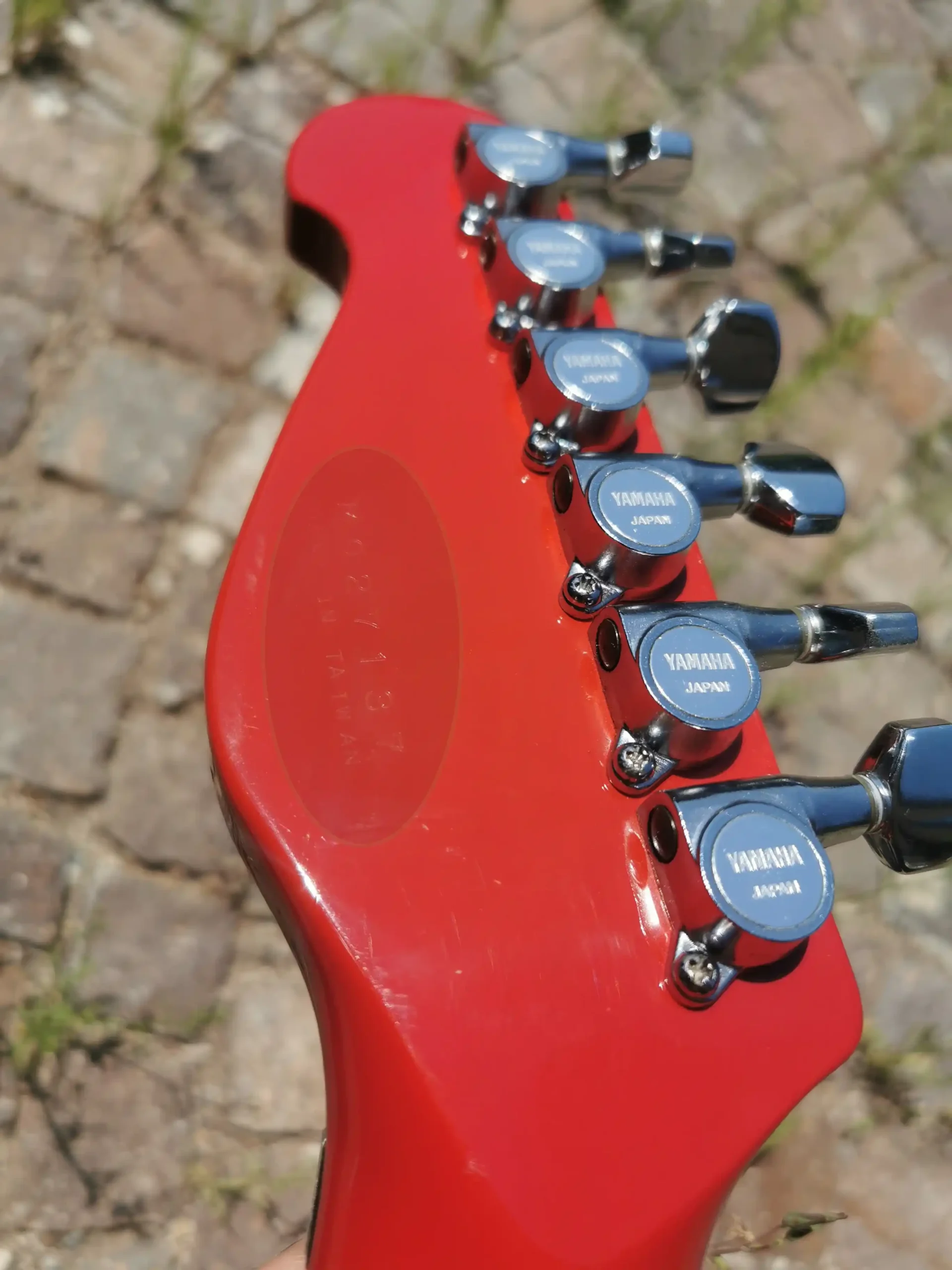
1984–2002: 7-digit format.
This format consists of two letters followed by five numbers (e.g., PH07123).
- The first letter represents the year (e.g., P = 1999).
- The second letter is the month (e.g., H = January).
- The first two numbers are the day of the month (e.g., 07 = 7th).
- The final three numbers are the unit number.
Example:PH07123 = January 7th, 1999, unit number 123.
Since 2002: 9-digit format.
This serial number contains three letters followed by six numbers (e.g., QJM120013).
- The first two letters represent the year (e.g., QJ = 2003).
- The third letter is the month (e.g., M = June).
- The next two digits are the day of the month (e.g., 12 = 12th).
- The last four digits are the unit number.
Example:QJM120013 = June 12th, 2003, unit number 13.
Made in Korea and Made in China Serial Number
Since 2003: 9-character format.
This format includes three letters, four digits, and a final letter (e.g., QKJ0011Y).
- The first two letters represent the year (e.g., QK = 2004).
- The third letter indicates the month (e.g., J = March).
- The four-digit number is the unit number.
- The last letter is an internal code, typically one of: D, R, U, or Y.
Example:QKJ0011Y = March 2004, unit number 11.
Dating Yamaha Guitar by Pickup
The older models of Yamaha electric guitars have a number on the back of the pickup. This is the production date.
However, this date is based on the Japanese Showa calendar, which spans from 1926 to 1989.
25 years must be added to the year on the pickup to determine the date according to the Gregorian calendar. An addition of 88 years applies for the Heisei period (1989-2019).
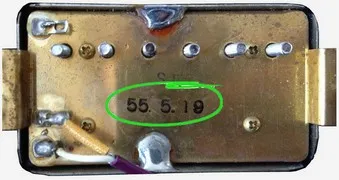
What applies to pickups also applies to the potentiometers. These were made before the guitar. For the year of construction of the guitar, approximately half a year must be added.
I’ve never owned a Yamaha guitar; fate just didn’t align that way. However, every time I had the chance to play one, it was always an interesting and unique experience. There’s something special about the quality, both in the materials and the construction of these guitars, that really impressed me. Well, maybe one day I’ll get myself a Yamaha. Time will tell.